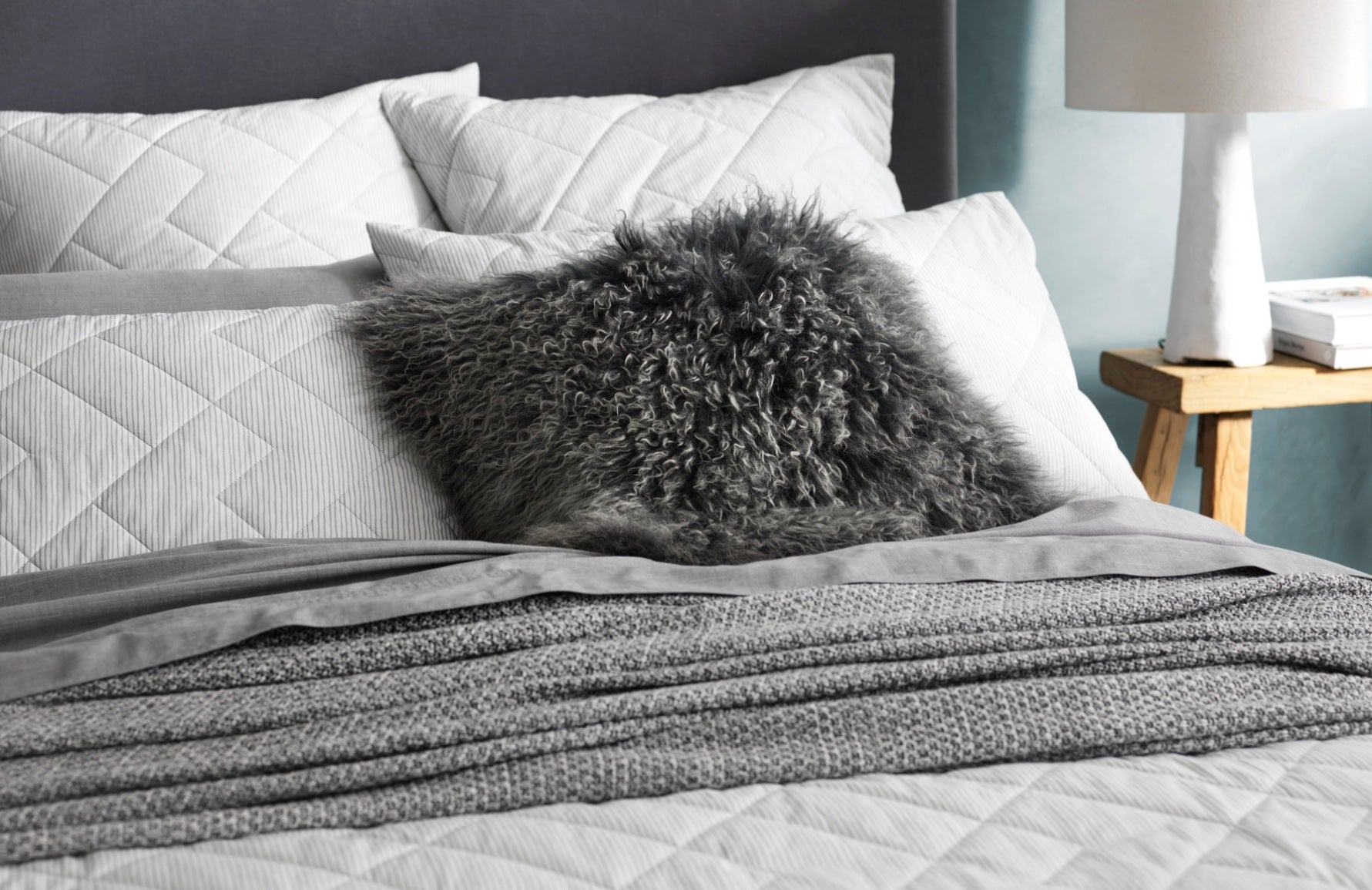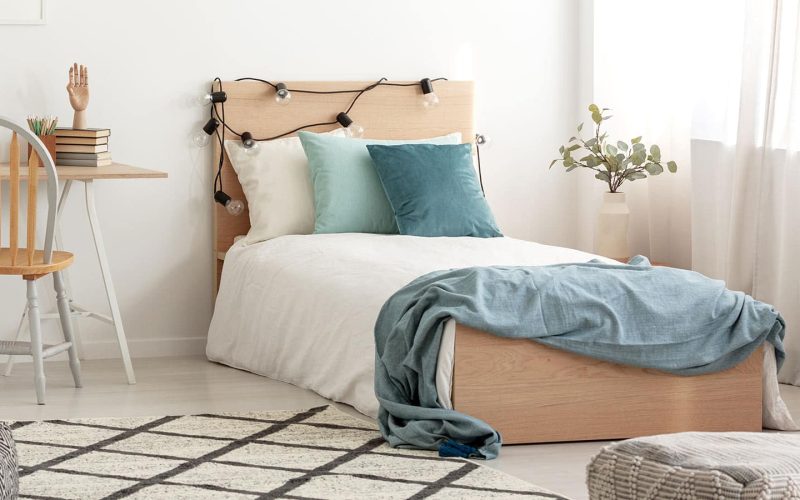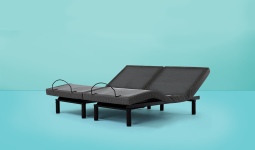The bed is the most comfortable place at home, and it is possible to relax in other parts of the house; we crave our beds after a hard day.
If this sounds untrue, you need to check your mattress and, most importantly, bedding. There are different types of bedding, and without the right one, you may never have a comfortable sleep, no matter how much you invested in your mattress.
This post will discuss the different types of bedding and how they can make your sleep more comfortable.
What is Bedding?
Bedding is a term that describes bed sheets, pillows, blankets, and other bed accouterments people use to protect, decorate, and cover their mattresses. There are different types of bedding, including fitted sheets, flat sheets, quilts, etc.
Different Types of Bedding
1. Fitted Sheet
A fitted sheet is the primary bedding layer with elastic bands around the edges. It’s usually snugly fitted on the mattress.
People who use a mattress protector lay their fitted sheet on top of it. The elastic band holds the sheets to the bed so they don’t come off in the middle of the night.
To have a well-made bed, ensure that the corners of your fitted sheet are tightly tucked around your mattress.
2. Flat Sheet
After the fitted sheets, the flat sheet is applied when making the bed. It is the layer that has direct contact with the body, must be hygienic, and must be made of easy-to-wash materials.
It barriers the body from other bed covers used for decoration or warmth.
Though traditional flat sheets are usually tucked down the mattress, luxury sheets are allowed to hang by the side of the bed to give a polished look.
3. Coverlet
A coverlet is a bed cover with decorative woven designs. Though it does not cover every part of the bed, it covers the bottom, with its sides hanging down a few inches below the box spring, but don’t touch the floor.
Though a coverlet can be tucked in, those with designed edge trim are usually untucked.
4. Duvet Cover
Duvet covers are protective and decorative materials used to cover inserted duvets. They are available in different fillings and weights.
Depending on the location, duvet covers can be used alone or on a flat sheet. Dressing the bed without the intermediary layers makes it less complex.
They are available in luxurious designs and layered over a quilt or blanket. Their placement on the foot of the bed makes it easy to pull up for warmth, and most times, the sides of a duvet cover are allowed to hang down to cover the boxsprings.
5. Comforter
A comforter is an easy layer placed on a mattress to do the work of a duvet or duvet cover. However, it is one piece with wide functional stitches to distribute the fillings evenly.
6. Blanket
The blanket generally describes any bed cover that’s ticker than a sheet, including duvets, quilts, and comforters.
They are primarily long, soft, woven fabrics available in different types, including microfiber, satin, polyester, and synthetic materials.
Though primarily used for warmth, the sides of a blanket drape over the bed to add beauty to the room.
Weighted blankets, filled with materials like glass beads or plastic pellets, offer additional benefits beyond warmth, such as comfort and security. They have gained popularity for their ability to promote relaxation and improve sleep quality, making them a sought-after choice for many individuals seeking a cozy and restful night’s sleep.
7. Blanket Cover
The blanket cover is a very light decorative material placed over a blanket for decorative purposes. It is primarily used in hotel beds to protect the blankets from dirt and dust and limit the wash frequency.
Like the flat sheet and fitted sheet, the blanket cover can be washed at once without ironing.
8. Quilt
The quilt is a blanket laid on the bed, but it is flatter and flusher than the comforter. Since quilts are not that fluffy, they don’t provide enough warmth as comforters.
A quilt has three layers: two fabric layers and batting stitched in between them. They are beautiful and valuable for decorative designs.
Though quilts are not that fluffy, they are dense and give a heavy feel to the body. Some luxury quilts can be used alone as a sheet, laid under a duvet cover, or on a blanket.
9. Bedspread
A bedspread is a decorative and lightweight material used to cover every bed part. It goes over the pillow and reaches the floor.
Bedspreads are an easy way to make a bed, hiding everything on the bed with just one swoop. They benefit people who want to protect their bedding set from dust mites, dirt, and other elements.
10. Throw
With trims or fringes, throw blankets provide extra warmth and decoration or cover the top of a bed. It is usually nicely folded at the foot of the bed or placed on top of any bed covering.
11. Pillows
There are two types of pillows, including throw pillows and sleeping pillows. The throw pillows are used for decorative purposes and are available in different styles and colors, while the sleeping pillows are the ones we sleep on, which are covered by pillowcases or pillow shams. A pillow sham is a decorative pillowcase used to hide the pillow.
12. Bed Scarf
Also called the bed runner, the bed scarf is a decorative material laid on the foot of the bed to cover the bedding from dirty legs, shoes, pets, or suitcases in a hotel.
Different Types of Bedding Materials

There are different types of bedding, so they are made from various materials. Cotton is the most popular.
Let’s look at them individually;
1. Cotton
Cotton is the most common bedding material. It is breathable, easy to wash and remove stains, and cool on the body.
With time, cotton sheets soften but maintain their durability. They are available in different types, including Egyptian, Pima, Upland, Flannel, and Jersey.
2. Bamboo
Bamboo is an environmentally friendly material for household goods, including bedding.
Bamboo bedding is softer than polyester or linen and is durable, breathable, hypoallergenic, and wrinkle-resistant.
3. Polyester
Polyester is best for bedding when blended with other materials because pure polyester sheets are rough. However, when blended, they are softer and provide more comfort.
These sheets are wrinkle-resistant, affordable, and easy to wash. They are your best friend if you do not need iron or steam.
However, polyester is oil-absorbent, water-resistant, and terrible at removing white stains.
4. Linen
Linen is light and airy and best for hot sleepers and people with allergies since they are naturally cooling and hypoallergenic.
However, stiffness is a disadvantage; the material tends to lighten when washed. Also, it is never as soft as cotton.
5. Tencel
As a brand name for Lyocell, this wood pulp product is available in different trees, especially the eucalyptus. It is wrinkle-resistant and environmentally friendly and can be recycled and reused.
Tencel is smooth, soft, and hypoallergenic. It is an excellent choice for eco-conscious customers; however, cotton and linen materials are more breathable than Tencel.
6. Silk
Silk is a natural fiber produced by silkworms and requires delicate care. It is a naturally hypoallergenic material but quite pricey and laborious to maintain.
Besides, silk sheets are perfect for adding romance to a room because they look cool and rich.
7. Microfiber
Microfiber is a blend of finely woven polyester, and it is less breathable than cotton but softer than polyester. It is an excellent sheet for kids as it doesn’t stain even when they eat or sleep with their dogs.
8. Satin
Satin sheets offer an alluring feel and are made from synthetic fibers. They are similar to silk and can add some romance to the room.
Satin sheets can be knitted or woven, but the woven ones are smoother than the knitted ones.
What to Consider When Choosing Your Bedding?
It is medically advised to sleep for 8 hours every day. For this to be possible, you must invest wisely in your bedding, as it affects your sleep quality. To buy the best bedding, always consider the following factors.
Breathability
Consider the temperature when buying new bedding, especially if you run hot when sleeping.
Except you feel chilly at night, stick to purchasing breathable fabrics. People who feel cold at night can go for bedding with a synthetic layer to help them retain some body heat.
Comfort
This is paramount when choosing your bedding. Bedding must give a comfortable feel, which depends on the fabric’s material and weave.
One thing to consider when selecting comfortable bedding is the thread count. The thread count is the number of woven threads per square inch of the bedding, ranging from 100 to 1,000.
Though it doesn’t equate to quality, softer sheets have higher thread counts and are usually more expensive than sheets with lower thread counts.
According to experts, buy bedding with 200 to 400 thread counts per square inch for the best results.
Quality
If you’re on a budget, you may be tempted to buy inexpensive but beautiful bed sheets. However, you can improve the quality of your sleep by investing more in your bedding.
Remember, your sleep quality affects your health in the long term, so always opt for high-quality bedding.
Hypoallergenic
If you have allergies, stick to bedding with antimicrobial properties. Your materials will likely resist mold and dust mites, making your sleep more comfortable.
Conclusion
There are different types of bedding, and choosing the best is essential for optimal sleep. However, when considering your mattress and sheets, always consider your primary requirements from your bedding.








